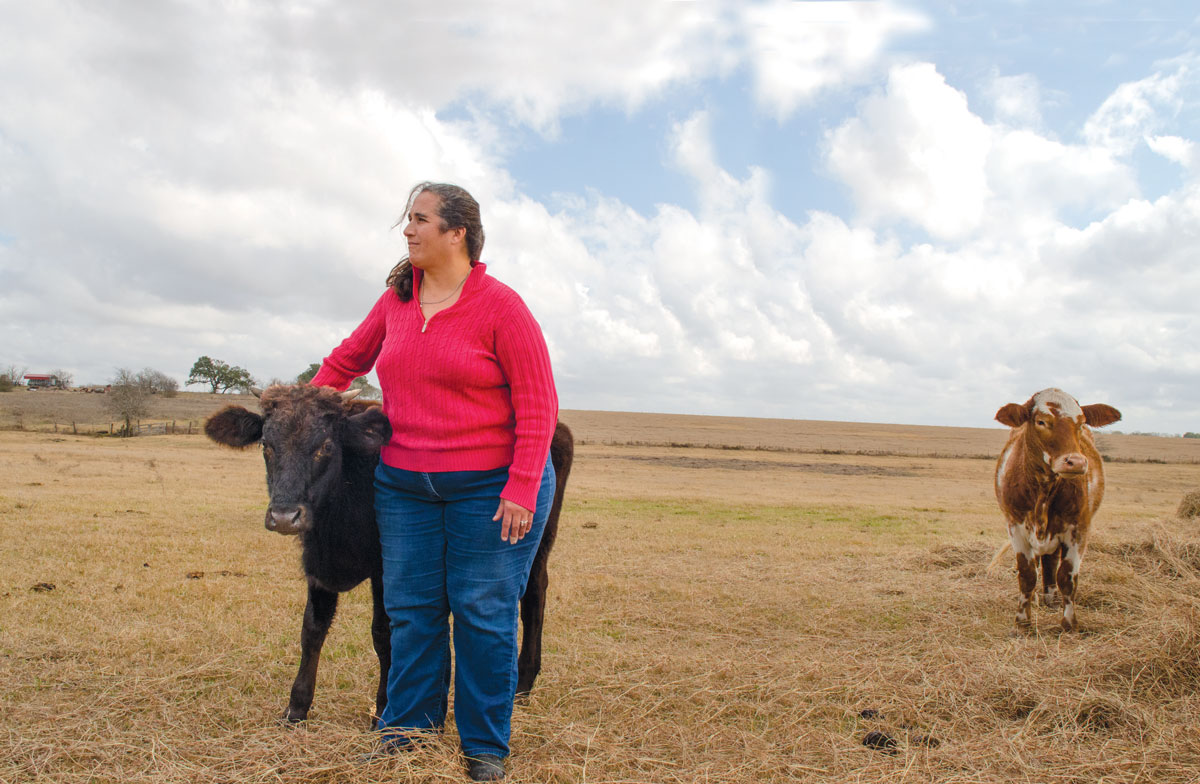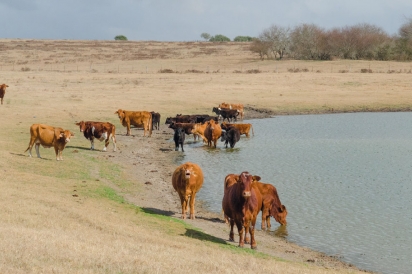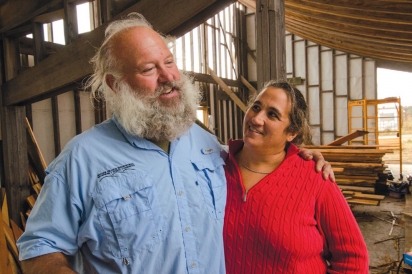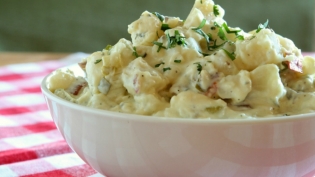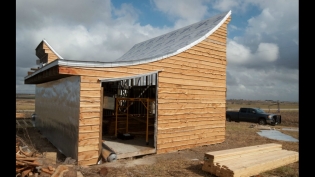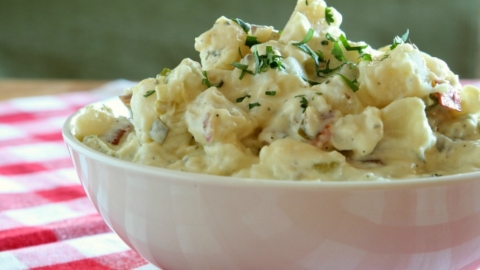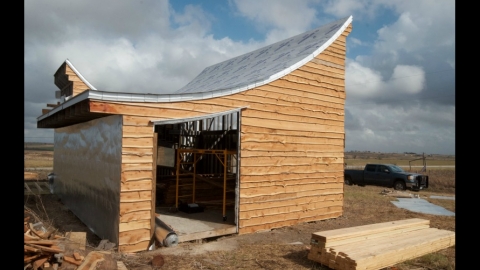Little House on the Shiner Prairie
Raising kids, cattle and hogs on Shiner Pork & Beef Farm
When 16-year-old Patricia Aristeguieta was dating Ross Tieken, one day he took her to his family’s farm, just outside the historic town of Shiner, about 110 miles west of Houston. “I literally climbed the fence to get away from the cows,” recalls Patricia, now Tieken, and co-owner and major operator of Shiner Pork & Beef.
Patricia Tieken is half Venezuelan and grew up living in different places—including Madrid and the Basque country in northern Spain—before she settled in Texas in her teens, dated and later married Ross Tieken, whose family heritage is German. The farm belonged to his grandparents, who bought it in 1948 and in 1951 built the house where the Tiekens now live.
The fence story is still a source of amusement in the family. “My kids always joke that I may live on a farm but I’m not a farm girl,” she says. But she is definitely a farmer. She worked on the farm from the day the couple first moved here, 10 years after she climbed that fence. She learned to operate a tractor, pull a trailer, mow the fields and handle cattle and hogs. “The farm now is mostly my job,” she says. “Ross is the furniture maker and woodworker.”
Ross Tieken’s workshop is an eye-catcher, with windows on all sides and “portholes” that follow the rounded roof. Trained as an architect, he designed the building on the footprint of his grandfather’s old concrete workshop, and built it together with son Ross Jr., 19 years ago.
“This area is known as the Shiner prairie. So the three-tiered arched roof is to reflect the rolling hills of the prairie,” says Ross. “You notice the windows stacked one on top of each other? As you look or move from the back to the front, the top window shifts this way, the bottom window shifts that way. It reflects the motion of KR Bluestem [a prairie grass] blowing in the wind. And those portholes, they represent sunrise to sunset.’”
Over the years Ross, Patricia and their four kids renovated the old farmhouse: making the timber ceilings, fitting the doors, redoing the wooden floors. Gender doesn’t enter the conversation when it comes to things you can do. It is how they raised their kids. “They have all built fences, they can all garden, they can all cook, they can all do whatever needs to be done,” says Patricia. Daughter Nicole chimes in wryly: “We can all lift 50-pound feed bags on our shoulders.”
We sit at the family dining table, a smooth wooden table with cabriole legs pointing outwards. It’s a piece by Ross. “We’ve had this table, what, 20 years? I home-schooled all my kids at this table right here,” says Patricia with a nostalgic glance at Nicole, sitting next to her at a German lunch of homemade sauerkraut, sausage ground from their own pork, potato salad and home-baked bread.
Nicole, a graduate of Texas A&M with a degree in equine science and studying for a teacher certification, is the second child and first daughter. Older brother Ross Jr., married with two small kids, is finishing a doctorate at Rice University; younger sister Abby is in her third year studying to be a veterinarian, also at Texas A&M. Youngest brother Aaron is finishing high school.
About eight years ago the Tiekens decided to raise hogs for market. They got Large Black hogs, a heritage breed that was almost extinct by the 1960s and is still considered vulnerable. Large Black hogs are a slow-growing breed and take at least 18 months to get to market weight, compared to the average six months for commercial hogs. It is worth it to Patricia.
“These are friendly, gentle animals that like to be outdoors,” she says. “They like to run and be in the sunshine. We don’t cut their tusks. They don’t bite us. I mean, our son’s broken his arm once but that was from running with a bucket of feed.”
The pigs are fed milo, a red grain sorghum grown for them by fellow farmer John Friesenhahn. He practices no-till farming (an agricultural technique aimed to naturally increase soil health) and doesn’t use any fertilizers or pesticides. Every two to three weeks the Tiekens drive to his farm to pick up 6,000 pounds of milo. Every day they grind 350 pounds of feed for the pigs. Double that if rain is expected the next day.
“We use an old grinding machine. It’s from the 1940s, and so is the tractor that powers it,” says Patricia. “It’s a dangerous machine to operate in the first place. And when it rains, the belt slips off.”
Some of her hogs are destined for Underbelly, where Chef Chris Shepherd utilizes the whole animal to make charcuterie. “All of our pork products in the curing room are from Shiner Pork,” says the chef. At the chef’s request, Patricia finishes Underbelly’s hogs on peanuts. “It yields a good, clean, white hard fat on the pigs,” says Chef Shepherd. Like the acorns famously fed to pigs in Spain, “it gives a sense of place.” Peanuts are grown in Texas, and Patricia sources hers from Wilco Peanut in Pleasanton, south of San Antonio.
When I visit the farm in early January, the fields are brown and dry and the cows feed on hay. Until spring turns the land a vibrant green with a carpet of wildflowers, the 18 head of cattle are free to roam much more widely than in other seasons, when paddocks are closed off so grasses can recover. Even on 90 acres of pasture, the cattle don’t wander off. Not in this herd. The bull is a Tajima breed, known for its herding skills: “They’ll grab a wandering cow and bring her back to the herd,” says Ross.
Once a month, Patricia takes a steer that has reached 1,000 pounds to a certified and inspected processor 15 minutes down the road, along with two hogs. The charge for processing averages $650 per steer and $350 per hog, which adds to the overall cost but the small-scale, individual handling ensures a most humane treatment.
“Eating meat comes at a price,” says Patricia, but she’s not talking about the monetary value. She cares for her animals. “We are feeling farmers,” she says. The steers raised for meat live where they were born, in a herd of 18 with ample pasture to roam.
For her, “grass fed” means more than healthy meat with unsaturated fat. “See this land?” She points to mark out the vast pastures. “We have 18 cows [bull and calves included] and they have all this to roam. If this was a feedlot, there would be hundreds of cattle just in this one paddock alone.”
“My ultimate goal is to make this farm sustain itself. We have a garden, fruit trees; we have eggs, turkeys that hatch their own eggs. We supply meat to the market but also to all of our children. They don’t buy pork or beef anywhere else: They come home with ice chests.”
Few would think of hard farm work, with its long hours and physical strain, as romantic. Yet Patricia Tieken just might. “One day I was out on the field mowing, and Ross was inside baking bread. ‘We’re a weird couple,’ I thought to myself,” she says. She wouldn’t want it any other way.
> Find Shiner Pork & Beef at Westchase Farmers Market (Th 3:30–6:30pm); Urban Harvest Eastside Farmers Market (Sa 8am–noon); and the last Tuesday of every month at Rice University Market (Tu 3:30–6:30pm)


